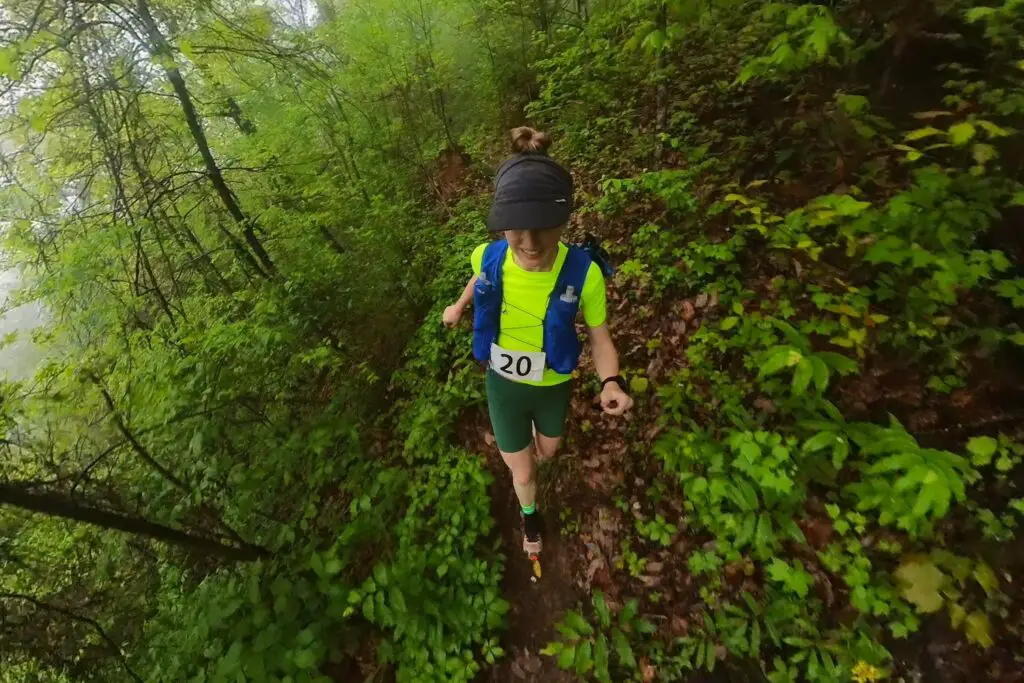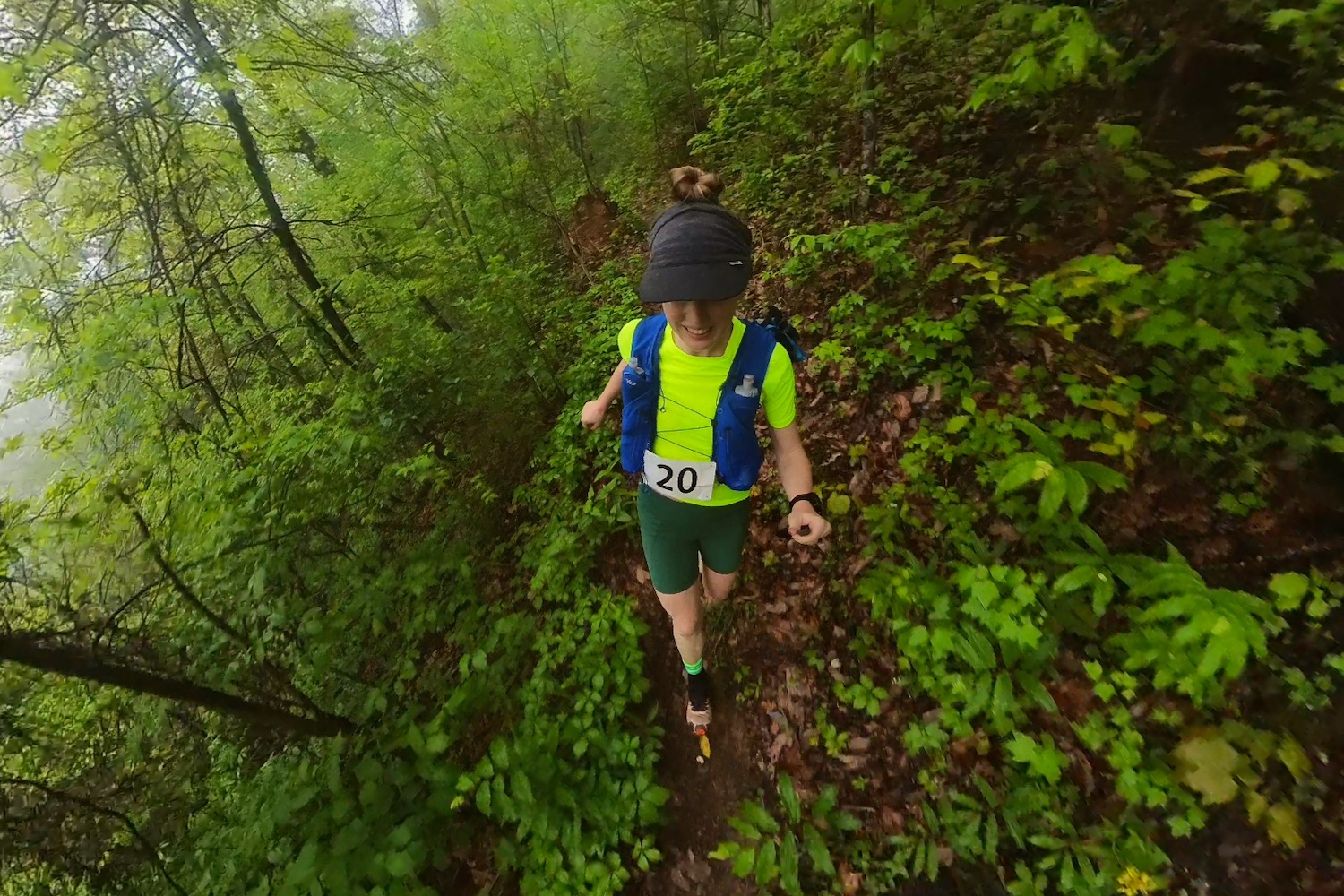There is something excruciating about running miles down a mountain only to turn around and run back up. But that is what we signed up for. We want to run a mountain, and the Chilhowee Mountain Ultra Marathon gives us just that: a mountain, 3,022 feet in elevation, and we climb it twice.
Of course, I wouldn’t blame anyone for asking why we want to climb a mountain. Despite embracing ultra marathons in the past year, we don’t welcome suffering. Trail running, to us, is more a matter of exploring the wilderness efficiently. We can cover more ground when we run and see more of it. And, hey, there’s something exhilarating in participating in a race.
This kind of thinking led us to sign up for the Silverheels 100K this summer. We were looking for a 50-miler to take our running to the next level, but the 100k looked so much more scenic than the 50-miler. So, we thought, “What’s an extra 12 miles and 2,000 feet, really?”
And, of course, the answer is: we don’t know. We haven’t raced on a mountain and are relatively new to ultra running. Our first ultra, Long Hunter, was a 50K but very flat for a trail run. Our second ultra, Stump Jump, is considered very technically difficult, but it doesn’t have the sustained climbs that we will encounter in Colorado. Not to mention, my performance at the Stump Jump was, personally, disappointing. Of course, I was sick, but how much of my 7:45 finish time was because I was sick, and how much of that was because I wasn’t as capable as I thought?
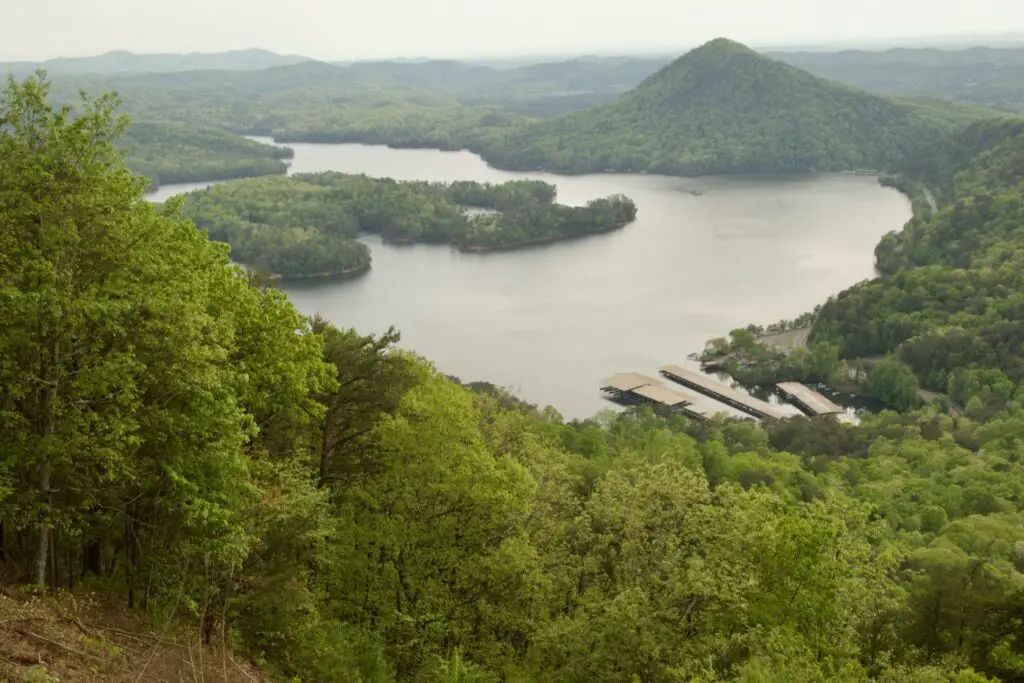
One Big Experiment
And so, as soon as we wash away the mud and sweat of the Stump Jump, we start searching for another race. Something mountainous. And something soon. With spring in full swing, the temperatures are getting warmer, and the conditions for running are less favorable.
And that’s how we settle on the Chilhowee Mountain Ultra Marathon, a mountainous course in mid-April, allowing us a month and a half to recover and train. The training, however, is less than ideal. While I do manage one significant long run (an 18-mile distance on mostly pavement), the two major long runs preceding the taper are both cut short. The first only covers 13 miles of trail before we run out of water. All our regular options to refill were shut off. The final run is an even more distressing 6 miles, two of which are spent limping back to the truck after I face-plant on the trail, leaving me with a bloody knee, bruised jaw, and fat lip.
But here’s the thing: despite my lack of long runs, there is one thing I do very well: speed hiking. My running might be in poor form, but I spend a lot of time trying to do everything but run when tackling steep inclines; the faster, the better. As similar as it may be to running, it isn’t running. And practice makes all the difference.
So, the day before the race, we hop in our reliable rig and drive to the group campsite at Chillhowee Campground. There, we meet the runners, pick up our bibs, and settle in for a characteristically fraught night.
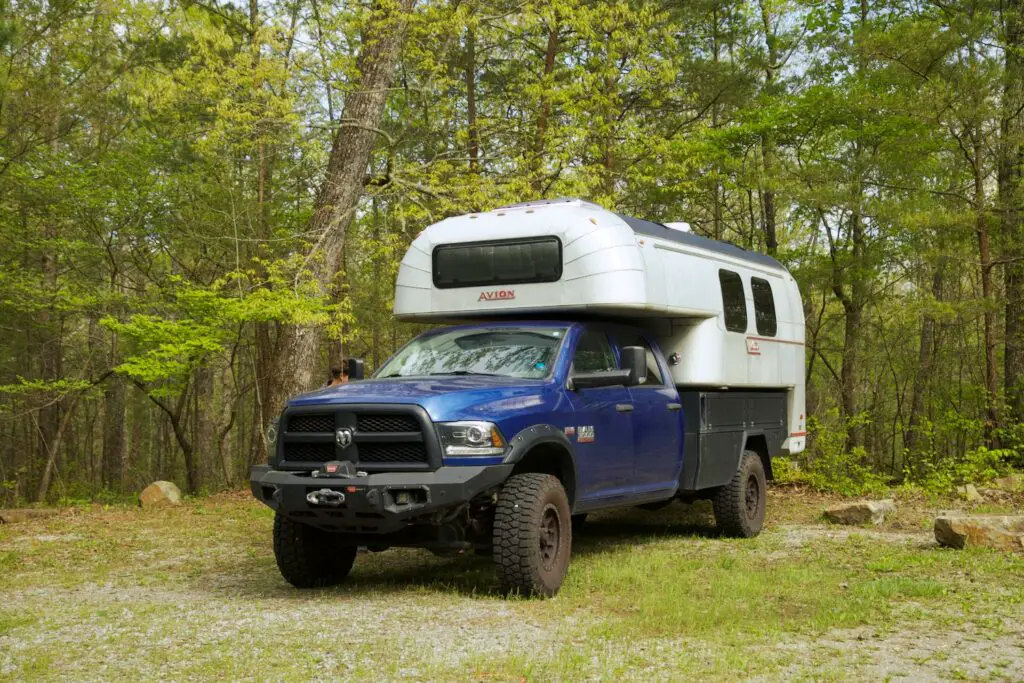
Race Day
The alarm goes off at 5:30 AM on race day. I roll over, crack open a soda, and mix up a bowl of cold oatmeal, nuts, and berries. Last night, I set out breakfast and soda on the side of the bed to expedite fueling and my first hit of caffeine. Breakfast in bed, ultramarathon style. The rest of the morning is spent taping feet, preparing our hydration packs, and making many trips to the bathroom.
The day is expected to be sunny and warm, but we wake to a drizzling fog at the start line. After a relatively short explanation of the course, the race director counts down to 8:30 AM, and we all charge down the trail.
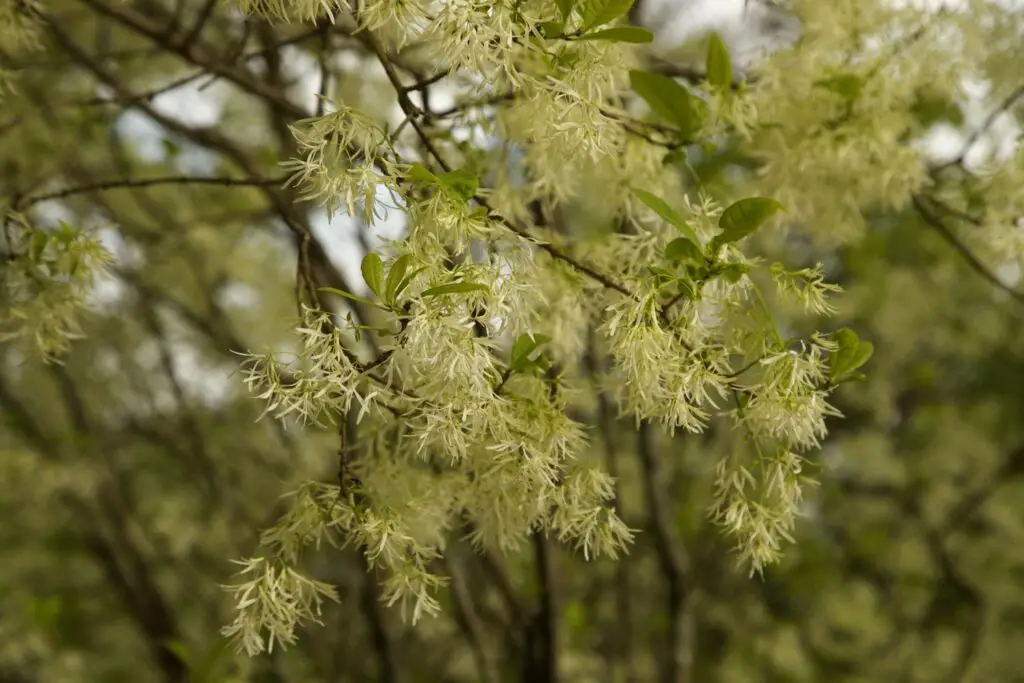
The Chilhowee Mountain Ultra Marathon
This is the inaugural Chilhowee Mountain Ultra Marathon, and the unsurprising small group of 25 runners account for both the 50k course and a more popular 25K course. We all charge down the 6-mile descent to Aid Station 1 by the shores of Lake Ocoee. It’s a steady downhill, and we fly through the fog, through a forest of rhododendrons, and hop over swollen creeks. There’s a magnificent waterfall somewhere to the left. I know, I’ve seen pictures. But I won’t be seeing it today. Instead, we skirt around Rattlesnake Hollow and into Aid Station 1 to refill our flasks and grab a Snickers and a PB&J. As far as we can tell, there are five men in front of us. I’m the first female.
As we turn back up the trail from the aid station, we encounter another female runner close behind us, though I have no idea if she is running the 25 or 50K race. Besides, I have plenty else to worry about: this next section is our first big climb, and there won’t be another aid station for 8 miles. Fortunately, the promised sunshine and warm weather are nowhere in sight. The fog and drizzling rain make it easy for us to conserve water as we gingerly cross a swollen Rock Creek and begin climbing the burned-out eastern flank of Rattlesnake Hollow. The ground is black and scorched here, but it hasn’t stopped tenacious dogwood saplings from budding and unraveling their first season’s leaves. It’s a strange, foggy world of black earth and brilliant green buds.

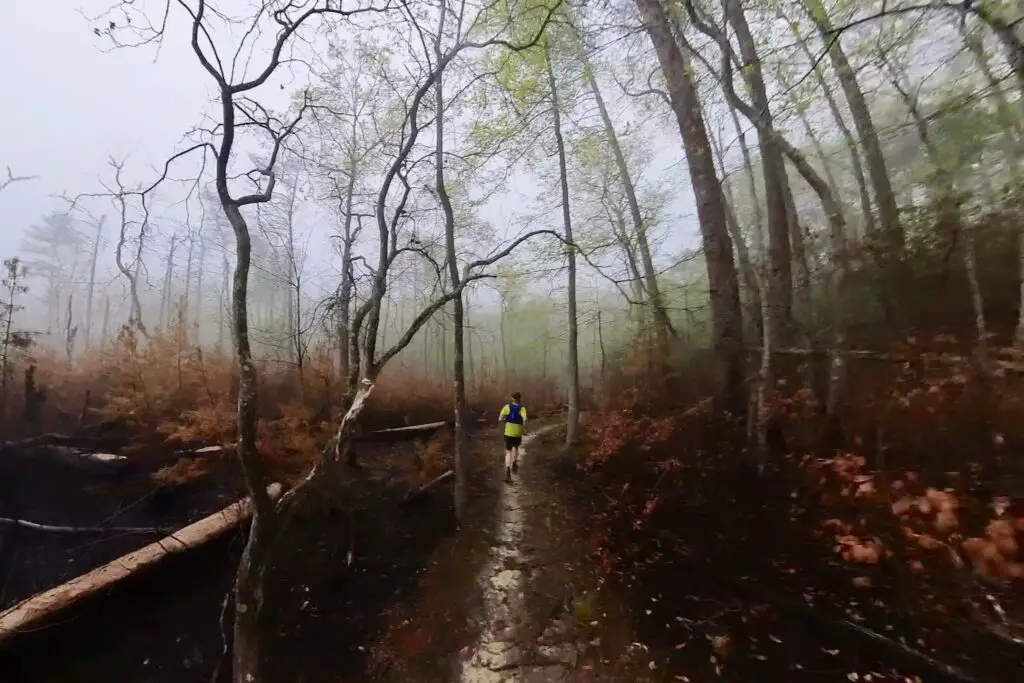
Clemmer Spur Trail Climb
We run up the initial incline of Clemmer Spur Trail but soon settle into an aggressive hike. We feel profoundly alone in the thick fog. Midway along the ascent, a figure emerges from a white bank of clouds: a man on an electric mountain bike in full camo with a shotgun strapped to his back. It is turkey season.
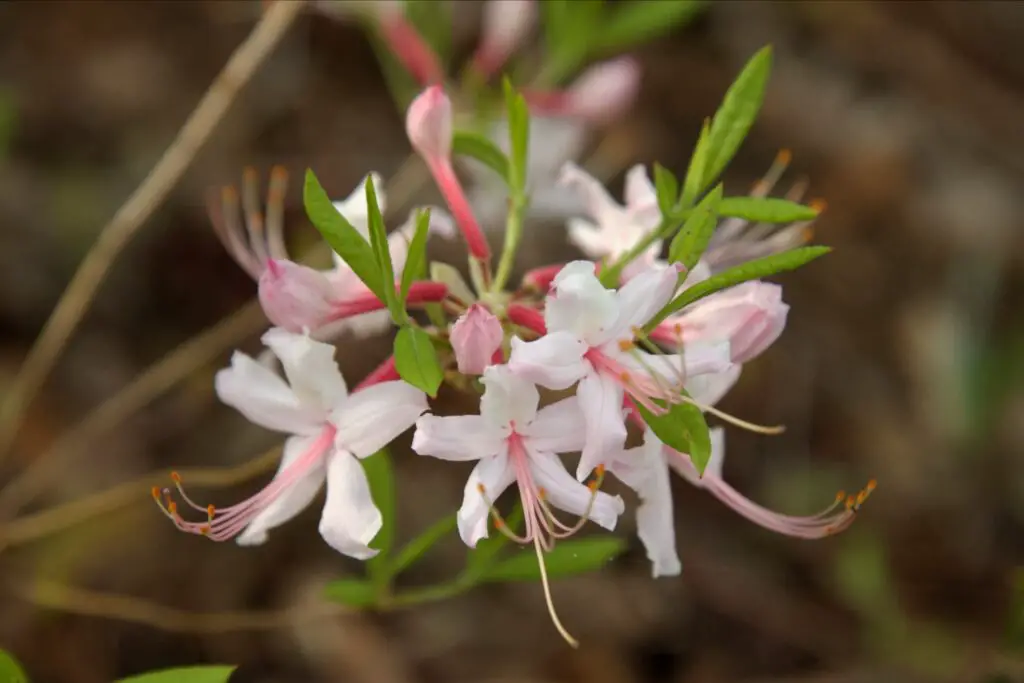
Clear Creek to Azalea Trail
While we continue to climb, the trail gradually flattens and deposits us on a dirt forest road. It’s a short distance down the road to Aid Station 2, where we can fill our flasks. Here, the 25K runners turn back to finish their race at the campground. We turn northwest to climb another 1,000 feet to the summit of Bean Mountain along a forest road.
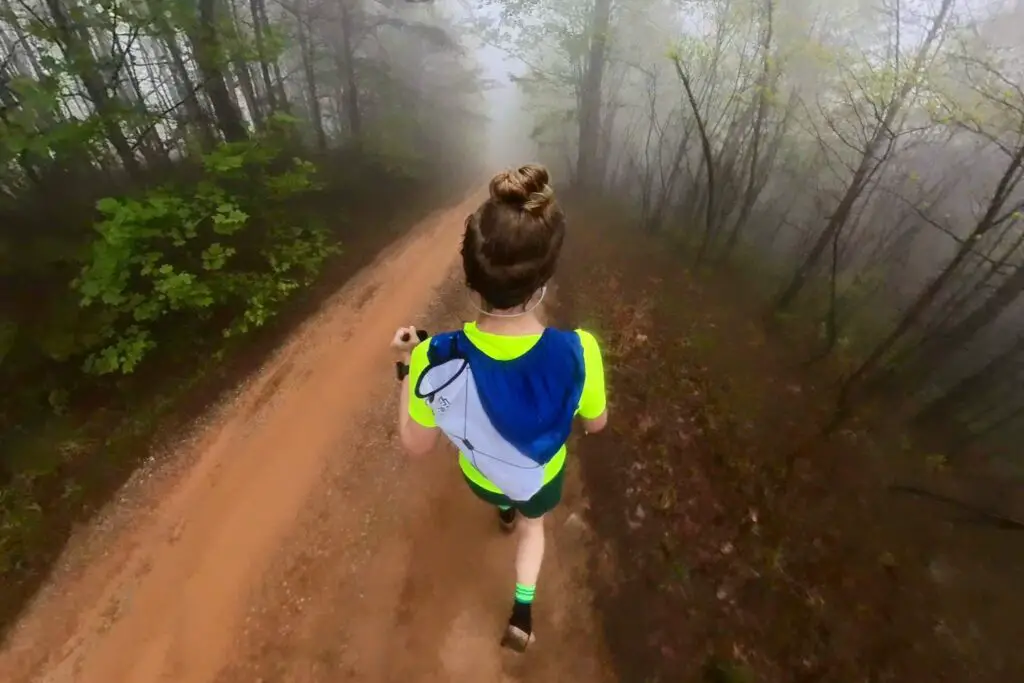
Climbing Oswald Road
Aside from a rare strait away or decline, we hike the next four miles. At times, it seems silly to walk. Under normal circumstances, I would run these inclines. But not for four miles. Not after all this climbing. We are both breathing hard at a constant, driven pace.
Even with a fast turnover of legs, four miles of hiking takes an incredibly long time, and we are relieved to finally reach Aid Station 3, just below Oswald Dome, the summit of Bean Mountain. Here, we have drop bags. I pull out my hiking poles, and Chris changes his shoes. By the time we are ready to leave, the woman from Aid Station 1 rolls in. Along with a cheerful wave and greeting, I feel that twinge of competitiveness.
It’s time to get moving.
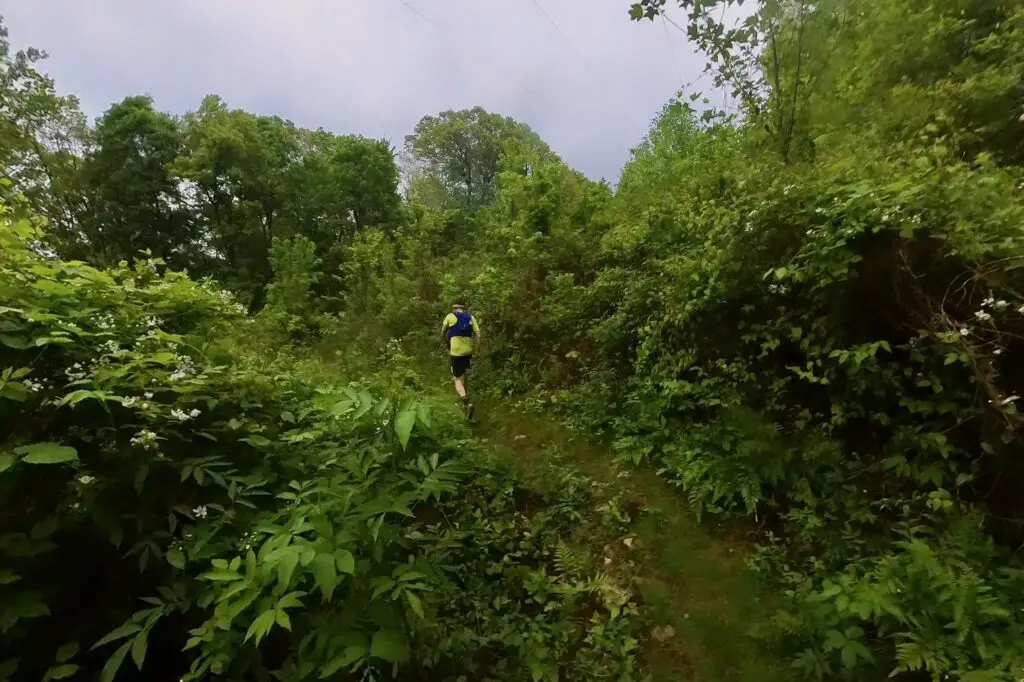
Lowry Cove Trail Descent
We run down the backside of Bean Mountain. It’s a four-mile descent to Hiwasse River and the foot of the mountain. The fog still tenaciously covers the mountainside as we wind through a dense understory of rhododendrons, moss, and a riot of wildflowers in full bloom. It’s a magical moment as we glide through this lush landscape. Despite the distance and steep decline, we maintain a steady footing. As we approach the base of the mountain, we also start encountering the runners in front of us, now ascending the mountain. They are looking strong and far ahead of us.
Granted, we keep hearing from the ascending runners that we are doing well, too. Part of that is the remarkably supportive community spirit that is part of trail running. Part of that is also the refreshing experience of a sustained downhill. Even the ladies (wo)manning Aid Station 4 at the base of the mountain say we are looking as fresh as when we came through Aid Station 1 (which they also staffed.)
We are grateful to fill our flasks and get another sandwich. At this point, I consider how much we have improved as runners since Long Hunter. It may have been only six months, but our strength is not the only thing that has improved. By this point of the Long Hunter, I struggled to take in calories. Today, I chomp away at my sandwich as we turn around to climb another 2,000 feet in four miles.
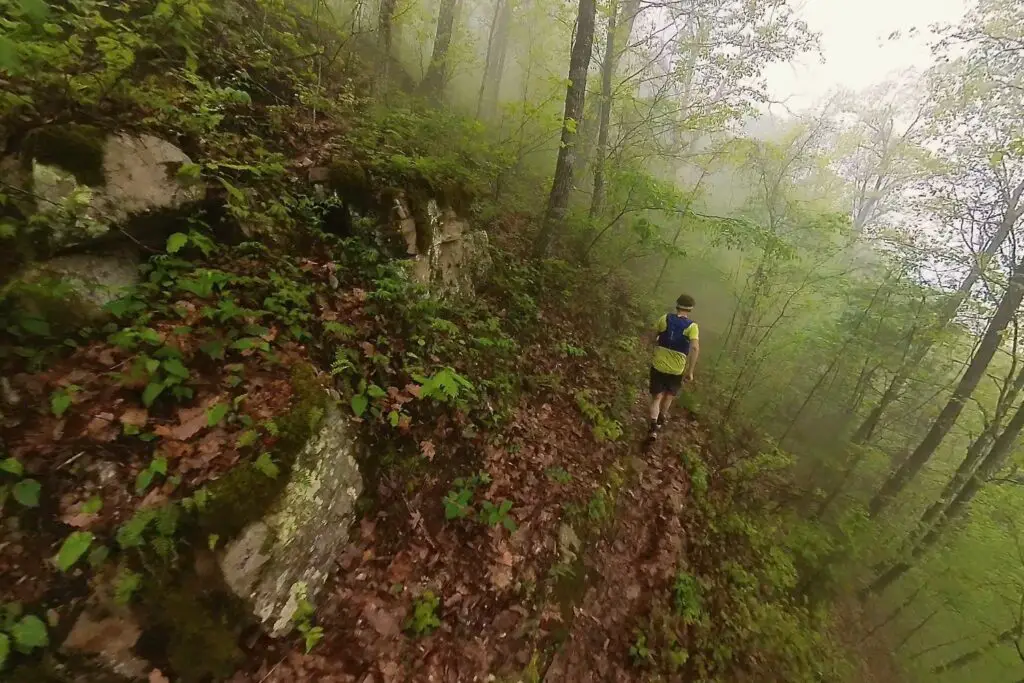
Lowry Cove Trail Ascent
It’s only .1 mile back up the trail before encountering the same female runner we’ve been bumping into across the course. Ever friendly and up for the challenge.
As soon as I finish my sandwich, I deploy the hiking poles and pick up speed. It’s a long climb, and more than anything, the poles keep me steady with a solid posture rather than straining my lower back.
There is no letup to this climb, but that is the point. The Silverheels 100k has four major summits. Each with an elevation gain similar to Bean Mountain. I may not be able to account for the altitude of Colorado, but at least I can test out the incline. And, oh, is it intense.
Up to this point, I’ve been running with one major consideration: get to the climb before the weather gets too hot. Aid Station 4 is the first time we exit the fog. But we quickly reenter its cool embrace as we climb back up Bean Mountain. We settle into a rhythm and lose ourselves in the flowers and the foliage while occasionally encountering other runners on their descent. I marvel at how gracious the lead runners were in our short exchanges when we encountered them climbing. Me? I’m so short of breath that it’s hard even to acknowledge the oncoming runner. But I can’t help but perk up when one runner notes that we’re less than a mile from the summit.
I think the runner’s math may be a bit off. But the climb certainly does taper off within a mile. We are still climbing, but at an incline; I’m almost embarrassed to admit that I do not run at this point. On any other day, I would have run it without a care. But it’s different after hiking uphill for miles. I keep trudging away until we encounter one of the leaders crouched on the side of the trail, taking a picture of a flower. We all admire the flower and then pass by. We are now in 4th place.
And now, it really is less than a mile to the summit and Aid Station 5 (Formerly known as Aid Station 3). Apparently, the volunteers have a whole betting bracket for the runners, and our approach has one crowing. We refill our bottles, grab some chips, and as we leave, we wave to our flower friend as he approaches the Aid Station.
It’s all downhill from here.
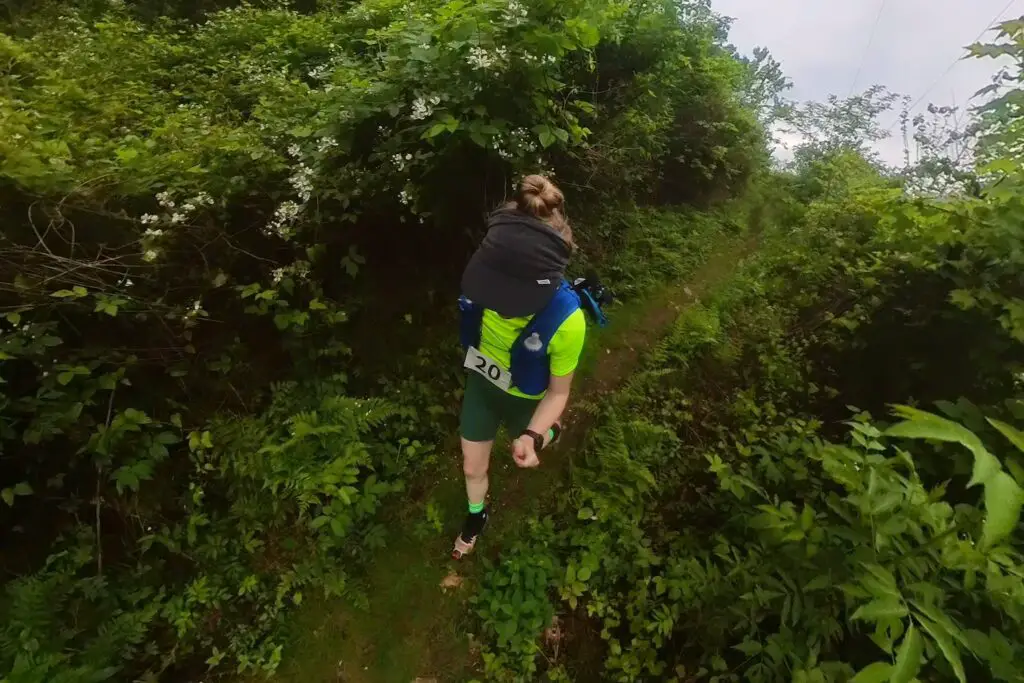
Oswald Dome Road Descent
I would say we flew down the mountainside. After all, we are back on the wide dirt forest road. Aside from occasional patches of rocks and ruts, the route is some of the easiest stepping yet. But after that last climb, my legs are cramped, and my lower back is sore. I try to stretch my legs and take wide strides, but it is a less dignified reflection of the downhill sprint that opened this race.
At one point, a line of service vehicles overtake us. There’s no clear place to take to the side. The idea of stopping to let them pass is excruciating, but after hopping over some overgrown brush on the side of the road in an attempt to keep moving while the vehicles pass, I eventually give in and stand still while the final vehicle passes.
Despite traffic and the accrued wear and tear of 25 miles on the trail, we eat up the four miles to Aid Station 6 (Formerly Aid Station 2). The volunteers are chatty, but aside from a quick swig of Gatorade, our focus is another three miles down the trail.
And one mile further, we are done with forest roads and back to the proper trail. I feel a second wind propel us up hills without the need to walk. There’s no more thought about endurance. With two miles left, it’s time to dig deep and leave everything we have on the trail. The route gently ungulates through shaded forest until it deposits us on a familiar paved road: the entrance to the campground. We turn down one last trail around McCamy Lake before heading south to the group campground and the finish line.
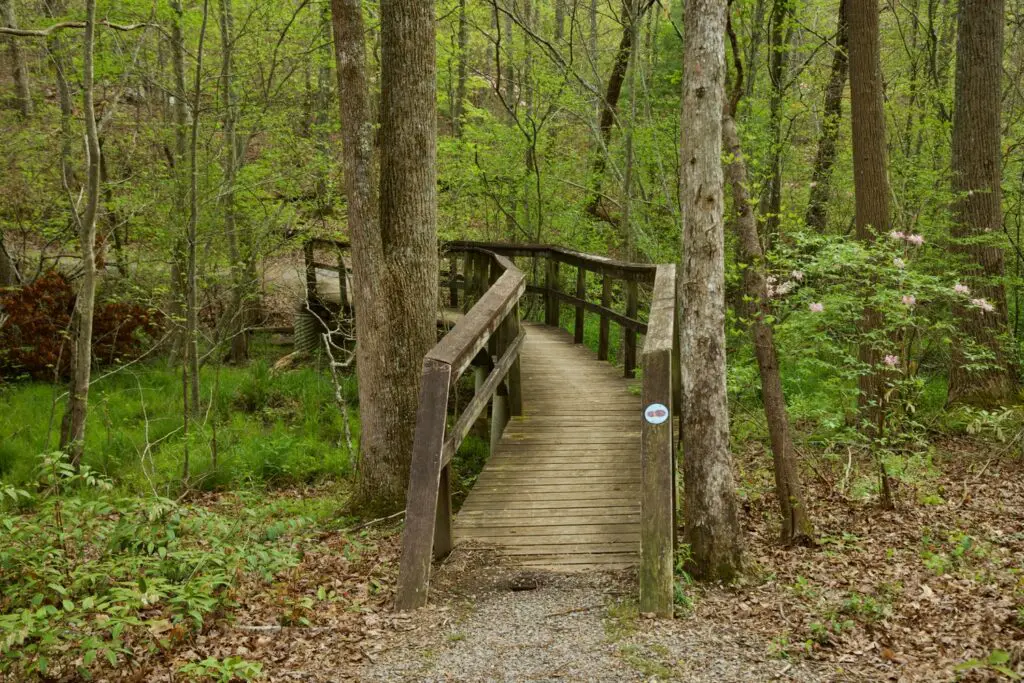
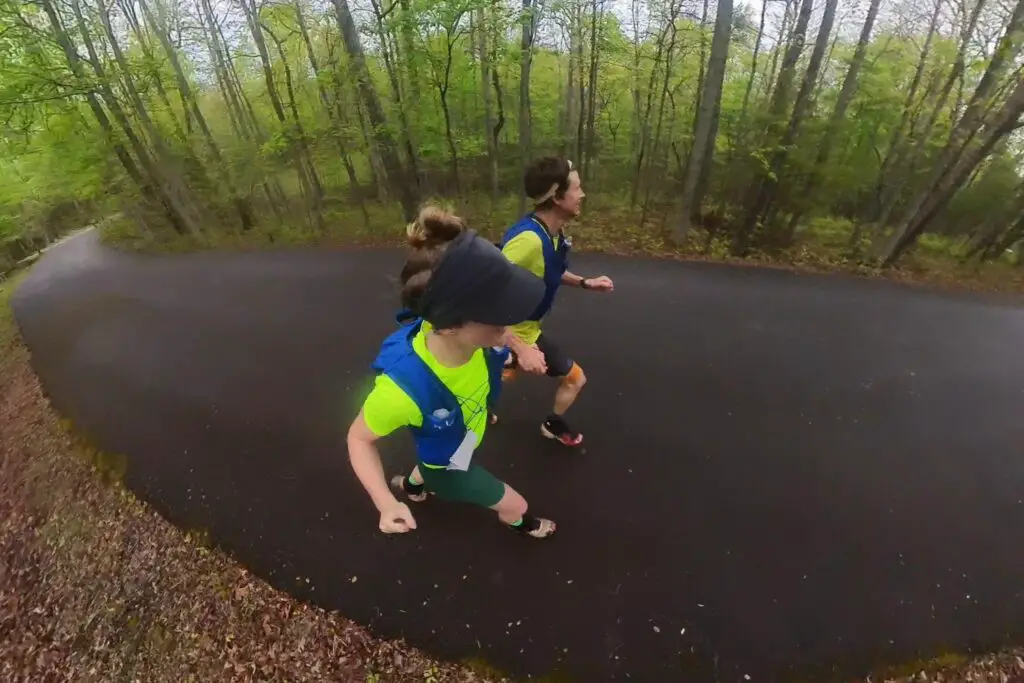
The Finish Line
Where that line is, exactly, isn’t entirely certain. We arrive at a line of cars behind which finishers and race organizers welcome us. The race timer calls out “6:21,” and I wonder what that’s relative to. We ran hard and gave it our all. But those steep inclines had us hiking much more than anticipated. After finishing at 7:45 at the Stump Jump, I figured a reasonable and meaningful goal for Chilhowee would be a sub-7-hour race. Yes, I guess we did do that. But by so much more than I had hoped. We ran up and down a mountain in 6 hours and 21 minutes. And I am ecstatic.
This was the finish I had dreamed of. Beyond an ambitious finish time, placing 4th overall and 1st female, we also chatted with other runners and race organizers. We cheered for the final finishers as they crossed the finish line. And shared a late lunch. It was a moment of community in a relatively lonely passion for us. Our friends and family listen to us babble about equipment, technique, and the latest races, but standing face-to-face with people who share our passions is a delight.
| Lap | Time | Pace | GAP | Elev |
|---|---|---|---|---|
| 1 | 8:43 | 8:43 /mi | 8:31 /mi | -52 ft |
| 2 | 9:36 | 9:36 /mi | 9:25 /mi | -56 ft |
| 3 | 9:02 | 9:04 /mi | 8:58 /mi | -23 ft |
| 4 | 9:39 | 9:40 /mi | 9:41 /mi | -75 ft |
| 5 | 9:16 | 9:17 /mi | 10:00 /mi | -358 ft |
| 6 | 10:21 | 10:22 /mi | 10:19 /mi | -371 ft |
| 7 | 10:48 | 10:48 /mi | 9:43 /mi | 26 ft |
| 8 | 10:42 | 10:45 /mi | 8:38 /mi | 230 ft |
| 9 | 17:02 | 17:03 /mi | 10:04 /mi | 535 ft |
| 10 | 12:15 | 12:16 /mi | 10:13 /mi | 16 ft |
| 11 | 10:27 | 10:28 /mi | 9:47 /mi | 13 ft |
| 12 | 11:25 | 11:26 /mi | 10:32 /mi | 69 ft |
| 13 | 11:07 | 11:08 /mi | 10:01 /mi | 85 ft |
| 14 | 12:26 | 12:28 /mi | 11:54 /mi | -26 ft |
| 15 | 11:14 | 11:15 /mi | 9:57 /mi | 52 ft |
| 16 | 15:04 | 15:05 /mi | 10:45 /mi | 427 ft |
| 17 | 16:07 | 16:08 /mi | 11:13 /mi | 449 ft |
| 18 | 18:30 | 18:31 /mi | 15:53 /mi | -36 ft |
| 19 | 11:13 | 11:14 /mi | 11:38 /mi | -476 ft |
| 20 | 12:22 | 12:24 /mi | 12:28 /mi | -804 ft |
| 21 | 11:35 | 11:36 /mi | 12:06 /mi | -600 ft |
| 22 | 15:13 | 15:14 /mi | 10:46 /mi | 259 ft |
| 23 | 18:40 | 18:42 /mi | 10:10 /mi | 745 ft |
| 24 | 18:23 | 18:23 /mi | 10:26 /mi | 696 ft |
| 25 | 13:38 | 13:39 /mi | 9:51 /mi | 384 ft |
| 26 | 10:20 | 10:21 /mi | 10:48 /mi | -381 ft |
| 27 | 8:24 | 8:25 /mi | 9:10 /mi | -407 ft |
| 28 | 8:47 | 8:47 /mi | 9:05 /mi | -312 ft |
| 29 | 11:28 | 11:30 /mi | 10:07 /mi | 85 ft |
| 30 | 9:08 | 9:09 /mi | 9:00 /mi | -85 ft |
| 31 | 11:02 | 11:02 /mi | 10:06 /mi | 49 ft |
| 32 | 7:05 | 9:39 /mi | 9:36 /mi | -49 ft |
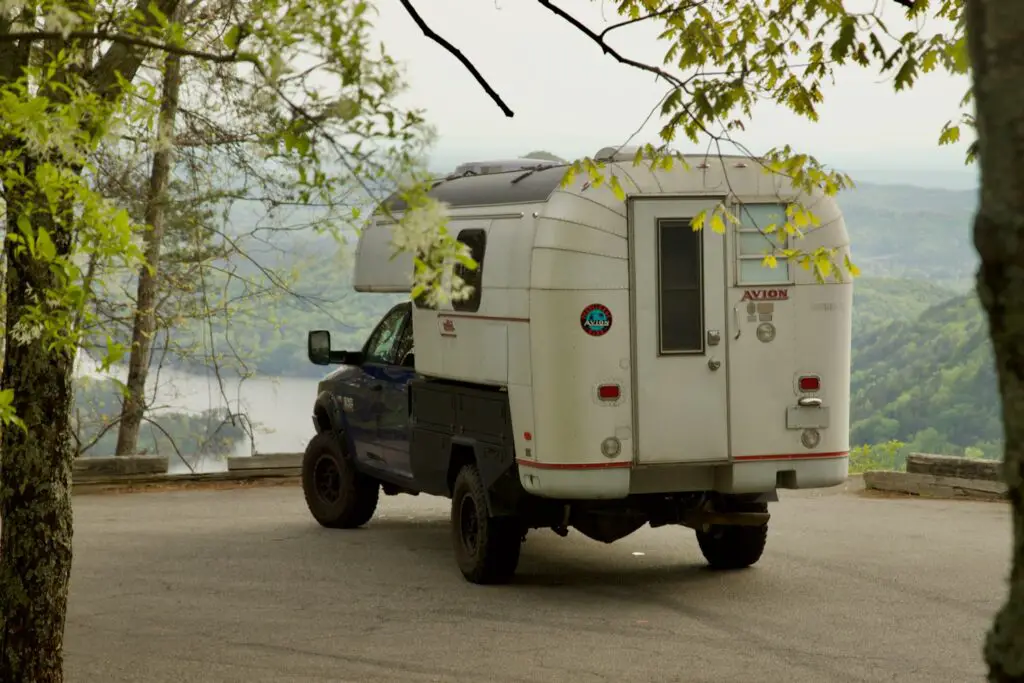
After the Chilhowee Mountain Ultra Marathon
I avoid sitting down until we are in the truck and on the move. My muscles are, predictably, sore. I feel a little ill. But compared to my past races, I feel solid. While I don’t initially have an appetite, I eat half a pizza before bed and even wake up hungry in the early morning to eat a small bowl of cereal and go back to sleep. Today, I am just sore. To me, it means I managed to fuel this race far better than on past occasions when I was plagued with headaches and nausea in the following days.
Lessons Learned
As much as I enjoy the opportunity to run a race, Chilhowee is more than a competition for us; it is an experiment. We test out speed hiking, poles, and our now-standard running outfits and prep on mountainous terrain. It isn’t completely comparable to the rugged peaks of Colorado, but it’s far closer than what we have experienced before, and we’ve learned a lot.
Training
Speed hiking is a game changer when training for a mountainous ultra. Not only does it focus on different muscles and techniques, but it’s also a great way to keep training when you may need a break from standard running. I plan to test integrating a stair machine into my training to emulate sustained steep climbs when I can’t access the real thing.
Gear
Hiking poles are useful for many things: maintaining balance while crossing a river, redistributing weight when climbing an incline, or prodding a snake out of the trail. But they particularly shine late in the race, where the extra two points of contact help maintain balance and take stress off other muscles to focus on forward propulsion rather than side-to-side balance.
Gortex is worth the price. While I generally train in standard running shoes, I’ve now run two races in my Salomon Speed Cross 5GTXs, and the difference between my nice, dry feet and Chris’s pale prune feet is undeniable.
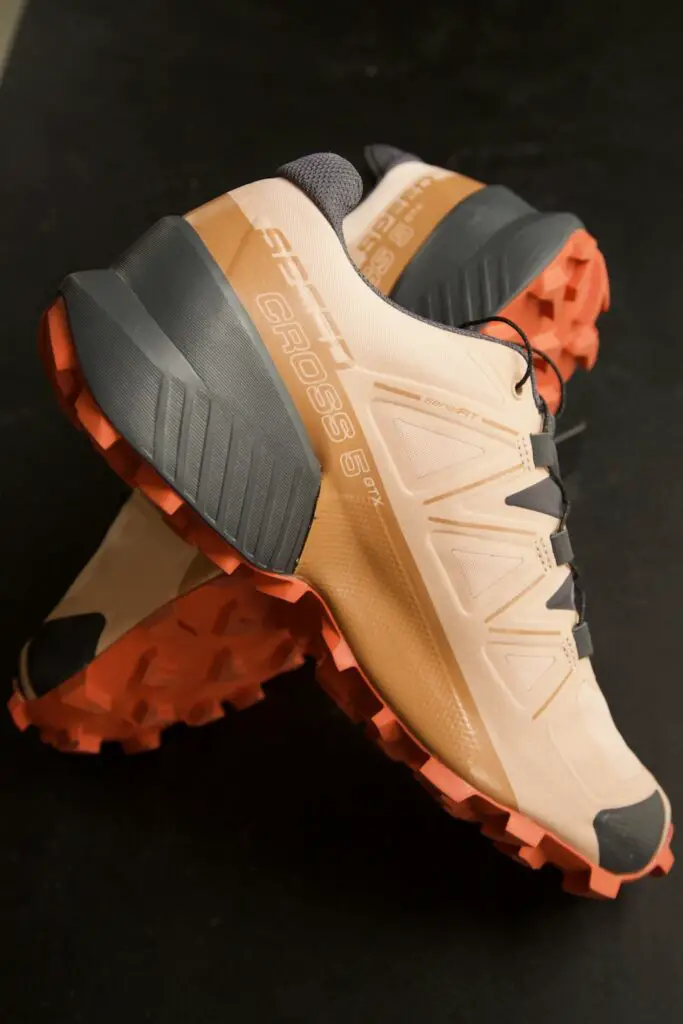
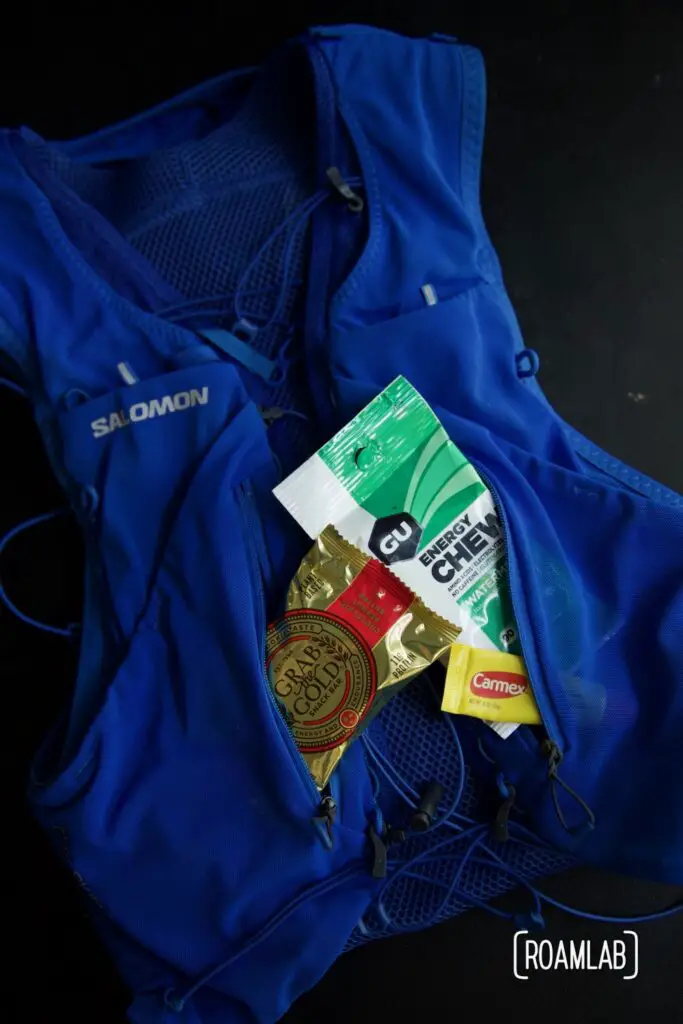
Strategy
Know the course. This isn’t a new insight, but it keeps coming up. Talking with the course director, he expressed how important it is to him that the race is well-marked. But, even so, there was one point when I was confused by the flagging. Fortunately, I had both a solid sense of the course layout from studying the maps and a turn-by-turn mapping of it on my watch on which to fall back.
As much as we’ve worked to shorten our times at Aid Stations, it’s also worth remembering that they are there for a reason. I packed a bunch of my nutrition for the race, and the only two pieces I bothered to eat during the race were two gels near the end. Training to rely on PB&Js, Snickers, chips, and Gatorade simplifies an uncrewed race.
What makes a fun race
The course makes the ultra. Despite how challenging Chilhowee is, it is also jaw-droppingly beautiful and scheduled perfectly at the height of the blooming wildflowers. No matter how rough the incline is, we find solace in the scenery.
Camping at the start line is the best! We only worry about eating, dressing, and every critical BM (bowel movement). Getting to the start line was just a short walk.
Small races are full of heart. This race has a personal touch. The race organizer and volunteers are all friends who went to college together and bring a rich sense of community to the event. That warm, group that welcomed us in at the finish line is all thanks to the passionate friends who care enough to plan and man a new race like this. And we are. profoundly grateful to get to be part of the beginning of a race that is sure to be a local favorite in years to come.
